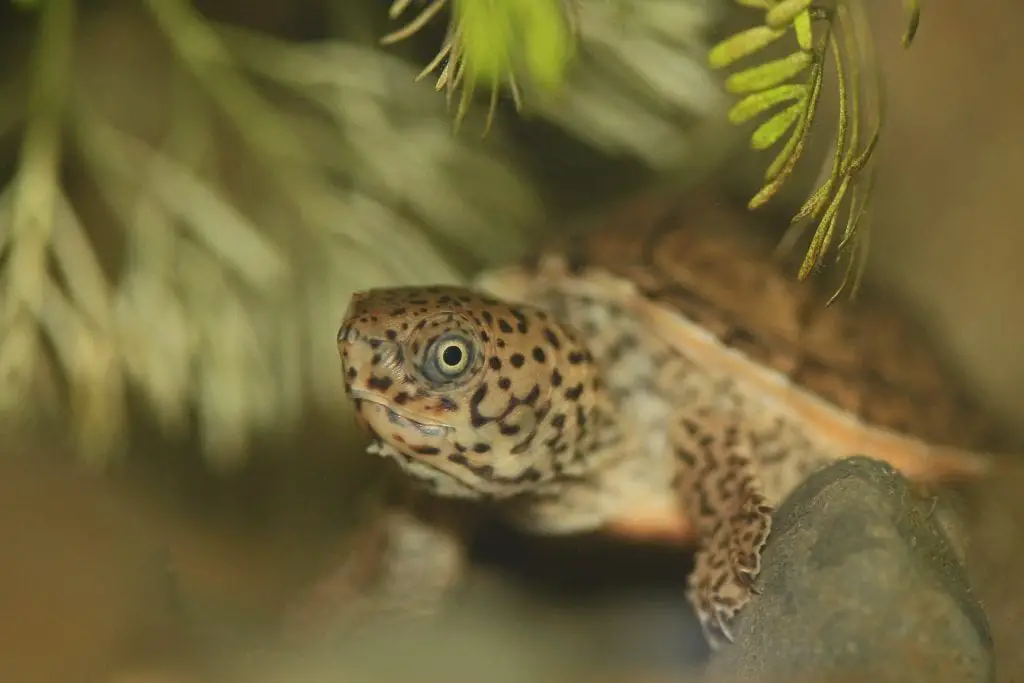The Loggerhead Musk Turtle, or Sternotherus minor, is a small aquatic turtle commonly found in the southeastern United States. These turtles are known for their large heads and are slightly larger than common musk turtles. They usually grow up to 4-5 inches in size and have a slight pink or yellow plastron.
Loggerhead Musk Turtles are fascinating creatures that have unique characteristics and habits. They have a light-colored background on their head and neck with dark spots or stripes present. They are also known to be more aquatic than their closely related mud turtles and prefer a larger-sized water area. While they are not frequent backers, they need ample opportunities to do so, and a spotlight over their basking area is essential.
This comprehensive guide will cover everything you need about Loggerhead Musk Turtles. From their physical characteristics to their habitat, diet, and behavior, we will provide all the information you need to understand these amazing creatures. We will also share tips on caring for them if you consider keeping their pets. So, let’s dive in and learn more about the Loggerhead Musk Turtle.
Identifying Loggerhead Musk Turtles
Loggerhead Musk Turtles are tiny turtles known for their distinctive physical characteristics. This section will discuss the physical characteristics that can help you identify a Loggerhead Musk Turtle.

Physical Characteristics
The Loggerhead Musk Turtle has a large head that is light-colored with dark spots or stripes present on the head and neck. The average size of an adult Loggerhead Musk Turtle is about 3-5 inches in straight carapace length. Compared to common musk turtles, their head is quite large, and they are generally larger. There will be a small plastron that’s pink or yellow.
The large head of the Loggerhead Musk Turtle is supported by powerful jaws that enable them to feed on hard-shelled prey, such as whelks and conch. The carapace of the Loggerhead Musk Turtle is smooth and has a central keel that runs down the middle of the shell. The stripe-necked musk turtle is another species that can be confused with the Loggerhead Musk Turtle. However, the stripe-necked musk turtle has a distinct yellow stripe on the side of its head.
Skin and Carapace
The skin of the Loggerhead Musk Turtle is typically brown or gray with a pattern of spots or stripes. The carapace of the Loggerhead Musk Turtle is smooth and has a central keel that runs down the middle of the shell. The carapace can be brown, gray, or black with a pattern of spots or stripes.
In conclusion, the Loggerhead Musk Turtle is a small turtle known for its large head, powerful jaws, and distinctive physical characteristics. By understanding the physical characteristics of the Loggerhead Musk Turtle, you can quickly identify this species from other turtles.
Scientific Classification
The Loggerhead Musk Turtle, also known as Sternotherus minor, is a turtle belonging to the family Kinosternidae. This family is part of the order Testudines, which includes all turtles and tortoises. The Loggerhead Musk Turtle is a reptile from the class Reptilia, characterized by its scaly skin and the ability to lay shelled eggs on land.
The scientific classification of the Loggerhead Musk Turtle is as follows:
- Kingdom: Animalia
- Phylum: Chordata
- Class: Reptilia
- Order: Testudines
- Family: Kinosternidae
- Genus: Sternotherus
- Species: Sternotherus minor
The Loggerhead Musk Turtle was first described by Agassiz in 1857. Webb later revised the species in 1959, Iverson in 1981, and Ernst and Lovich in 2009. R. Barbour also contributed significantly to the study of the Kinosternidae family.
The Loggerhead Musk Turtle is a small turtle with an average size of 3-5 inches in straight carapace length. They have a large head with a light-colored background and dark spots or stripes present on the head and neck. Their heads are usually brown or light grey with either spots or lines. The plastron, or underside of the shell, is small and pink or yellow.
In conclusion, the Loggerhead Musk Turtle is a fascinating species of turtle that belongs to the family Kinosternidae. Its scientific classification is well understood and has been studied by many researchers. It is essential to continue studying and protecting this species to ensure its survival for future generations.
Habitat and Distribution
The Loggerhead Musk Turtle is a freshwater turtle native to North America. They are found in various habitats, including rivers, ponds, lakes, streams, and springs. In this section, we will discuss the geographical range and habitat preferences of the Loggerhead Musk Turtle.
Geographical Range
The Loggerhead Musk Turtle is found in the southeastern United States, primarily in Florida, Georgia, Alabama, and Louisiana. They are also found in other parts of the United States, including Virginia, South Carolina, and North Carolina. The range of the Loggerhead Musk Turtle extends westward to Texas.
Habitat Preferences
The Loggerhead Musk Turtle is a semi-aquatic species that spends significant time underwater. They prefer slow-moving bodies of water, such as ponds and swamps, rich in vegetation. They are also found in high-velocity habitats, such as rivers and streams, where they can find food.
The Loggerhead Musk Turtle’s substrate can be either rock or sand. They are often found in vegetation-rich areas, such as marshes and wetlands. They are also known to inhabit areas with underwater structures, such as submerged logs and rocks.
In conclusion, the Loggerhead Musk Turtle is a freshwater turtle species primarily found in the southeastern United States. They are found in various habitats, including rivers, ponds, lakes, streams, and springs. They prefer slow-moving bodies of water rich in vegetation and are often found in areas with underwater structures.
Diet and Feeding Habits
The Loggerhead Musk Turtle is a carnivorous species that primarily feed on animal matter. They are opportunistic feeders, meaning they will eat whatever food they can. The Loggerhead Musk Turtle feeds on various prey, including fish, snails, insects, and mollusks. They are also known to consume small amounts of plant material.
In the wild, the Loggerhead Musk Turtle feeds on various aquatic insects, such as dragonflies and mayflies, as well as small fish, crayfish, and snails. They also feed on mollusks, such as clams and mussels. The Loggerhead Musk Turtle is a skilled hunter who can catch prey on land and water.
In captivity, the diet of the Loggerhead Musk Turtle should consist of a variety of prey items. They can be fed a variety of insects, such as crickets and mealworms, as well as small fish, such as guppies and minnows. They can also be fed commercial turtle food pellets formulated to meet their nutritional needs.
It is important to note that the Loggerhead Musk Turtle is a carnivorous species and should not be fed a diet high in plant material. While they may consume small amounts of plant material in the wild, their diet should primarily consist of animal matter.
Reproduction and Lifespan
Mating and Incubation
Loggerhead Musk Turtles reach sexual maturity at around 3-5 years of age. Males are smaller than females and have longer tails. During the breeding season, males actively search for females and court them by swimming around them and extending their claws toward the female. Once the female is receptive, the male will mount her, and copulation will occur.
Females will lay elliptical-shaped eggs, with clutch sizes ranging from 1 to 5. These eggs are usually laid in the early summer months and buried in a nest the female has dug in the soil or sand. The incubation period for these eggs is around 2 to 3 months, with the temperature of the nest determining the sex of the hatchlings. Cooler temperatures will produce males, while warmer temperatures will produce females.
Growth and Lifespan
Loggerhead Musk Turtles have a relatively short lifespan compared to other turtle species, with an average lifespan of around 20 years in the wild. In captivity, they can live up to 23 years. These turtles have a slow growth rate, with hatchlings measuring around 1 inch in length. They can grow up to 5 inches in length, with males typically being smaller than females.
Proper care and nutrition are essential to ensure that Loggerhead Musk Turtles live long and healthy life. They require a balanced diet that includes animal and plant matter and a clean and spacious enclosure with a basking area and a water source. Regular veterinary check-ups are essential to ensure that any health issues are caught early and treated promptly.
In conclusion, Loggerhead Musk Turtles have a relatively short lifespan compared to other turtle species, but they still offer a long life that can be enjoyable when in good health. Proper care and nutrition are essential to live a long and healthy life.
Behavior and Adaptations
Daily Activities
Loggerhead Musk Turtles are diurnal, which means they are active during the day. They spend most of their time in the water but bask in the sun on rocks or logs to regulate their body temperature. When they bask, they stretch their limbs and expose their shells to the sun. This behavior is essential for their health as it helps to improve their metabolism and digestion.
These turtles are also known for their unique filtration system. They have a specialized gland in their cloaca that helps them filter out excess salt from their body. This adaptation allows them to live in brackish water, a mixture of salt and freshwater.
Defense Mechanisms
Loggerhead Musk Turtles have several defense mechanisms to protect themselves from predators. When they feel threatened, they can retract their head and limbs into their shell, exposing only their hard outer shell. They can also release a foul-smelling liquid from their glands to deter predators.
Another adaptation that helps them defend themselves is their ability to hold their breath for long periods underwater. They can slow down their metabolism and absorb oxygen from the water through their skin, allowing them to stay submerged for extended periods.
In addition to these defense mechanisms, they also hibernate during winter when the water temperature drops. During this time, they burrow into the mud at the bottom of the water and slow down their metabolism to conserve energy.
Overall, Loggerhead Musk Turtles have unique adaptations and behaviors that help them survive in their environment. Their ability to bask, filter excess salt, defend themselves, and hibernate is essential to survival.
Conservation Status and Threats
Predators and Threats
The Loggerhead Musk Turtle is not listed as endangered or threatened by the IUCN Red List, and its conservation status is categorized as “Least Concern.” However, the species still faces various threats to its survival. Loggerhead Musk Turtles are preyed upon by many animals, such as raccoons, alligators, snapping turtles, skunks, and cottonmouths. These predators often raid nests and consume eggs and hatchlings. Adult turtles are also vulnerable to predation by larger animals.
Another significant threat to the Loggerhead Musk Turtle is habitat destruction and degradation. As human populations continue to grow and expand, the turtles’ natural habitat is being destroyed or fragmented, leading to a decline in their population. Pollution is also a significant threat to Loggerhead Musk Turtles, as they can ingest or become entangled in plastic and other forms of marine debris.
Conservation Efforts
Although the Loggerhead Musk Turtle is not listed as endangered or threatened, conservation efforts are necessary to ensure its continued survival. One of the primary conservation efforts is to protect the turtles’ natural habitat and nesting sites. This includes efforts to reduce pollution and prevent habitat destruction and fragmentation.
Another conservation effort is the regulation of the pet trade. Loggerhead Musk Turtles are sometimes kept as pets, and unregulated trade can lead to over-harvesting and depletion of wild populations. Some states have implemented regulations to limit the number of turtles that can be taken from the wild or prohibit the collection of turtles altogether.
Overall, conservation efforts for the Loggerhead Musk Turtle are ongoing, and it is essential to continue monitoring their population and threats to ensure their survival.
Loggerhead Musk Turtles as Pets
If you’re looking for a small and easy-to-care-for turtle, the loggerhead musk turtle might be your perfect pet. Here’s what you need to know about keeping these turtles as pets.
Health and Care
Keeping your loggerhead musk turtle healthy is relatively easy but requires some effort. Here are some things you should keep in mind:
- Habitat: Loggerhead musk turtles are aquatic, so they need a tank that’s at least 20 gallons in size. The tank should have a basking area, a filter, and a heater to keep the water temperature around 75-80°F.
- Diet: These turtles are omnivores and will eat various foods, including pellets, insects, and vegetables. It’s essential to feed them a balanced diet and to avoid overfeeding them.
- Health issues: Like all pets, loggerhead musk turtles can get sick. Some common health issues include respiratory infections, shell rot, and parasites. If you notice any signs of illness, such as lethargy or loss of appetite, take your turtle to a veterinarian specializing in reptiles.
Purchase and Legalities
Before buying a loggerhead musk turtle, it’s essential to ensure you’re getting it from a reputable source. Here are some things to keep in mind:
- Legalities: In some states, owning a loggerhead musk turtle as a pet is illegal. Make sure you check your local laws before purchasing one.
- Breeder vs. pet store: While you can find loggerhead musk turtles at pet stores, it’s generally better to buy them from a breeder. Breeders tend to take better care of their turtles and can provide more information about their health and history.
- Cost: The cost of a loggerhead musk turtle can vary depending on where you buy it and whether it’s a hatchling or an adult. Expect to pay anywhere from $50 to $200 for a healthy turtle.
A loggerhead musk turtle might be the perfect choice if you’re looking for a small and low-maintenance pet. Just make sure you do your research and provide them with the care they need to stay healthy and happy.
Interesting Facts
Loggerhead Musk Turtles are fascinating creatures with a lot of interesting facts. Here are some of the most intriguing ones:
- Biology: Loggerhead Musk Turtles are one of the smallest musk turtles, usually measuring around 4-5 inches long. They have a large head compared to other musk turtles, where they get their name. They are typically found in freshwater areas such as rivers, swamps, and oxbow lakes and often in places with abundant vegetation. These turtles are omnivores but mostly feed on small aquatic animals such as insects, crustaceans, and mollusks.
- Carr: Loggerhead Musk Turtles are known for their ability to tolerate a wide range of environmental conditions, which makes them highly adaptable. This means that they can survive in different types of freshwater habitats, from slow-moving rivers to fast-flowing streams. They are also able to tolerate water pollution to some extent, which is a useful trait in today’s world.
- Buhlmann: One of the most interesting facts about Loggerhead Musk Turtles is their long lifespan. They can live for over 20 years in the wild and up to 50 years in captivity. This means that they can potentially outlive their owners, which is something to keep in mind before getting one as a pet.
- Tuberville: Loggerhead Musk Turtles are not very social animals, and they tend to be solitary most of the time. However, during the breeding season, males become more active and may engage in territorial disputes with other males. Females usually lay their eggs in sandy areas near the water, and the eggs hatch after about 60 days.
- Gibbons: Loggerhead Musk Turtles are not endangered, but their populations are declining due to habitat loss, pollution, and poaching. They are also sometimes caught as bycatch in fishing gear, which can be fatal for them. Conservation efforts are underway to protect these turtles and their habitats, and it is important for everyone to do their part to help preserve these amazing creatures.
Frequently Asked Questions
What is the recommended tank size for a musk turtle?
The recommended tank size for a Loggerhead Musk turtle is at least a 40-gallon tank. This is to ensure that the turtle has enough room to swim, bask, and move around. However, it is always better to provide a larger tank if possible. A larger tank will provide more space for the turtle to explore and will help keep the water cleaner for a longer period of time.
What are the dietary requirements for a loggerhead musk turtle?
Loggerhead Musk turtles are omnivores and require a balanced diet of both animal and plant matter. The majority of their diet should consist of protein-rich foods such as insects, worms, and small fish. They also require a variety of vegetables and fruits to ensure they receive all the necessary nutrients.
How do you properly care for a musk turtle?
Proper care for a Loggerhead Musk turtle includes maintaining a clean and appropriate environment, providing a balanced diet, and monitoring its health regularly. The tank should be cleaned regularly, and the water should be kept at a suitable temperature. They require a basking area with a heat lamp to regulate their body temperature. Additionally, they should be handled with care and kept away from any potential predators.
What are some common health issues for musk turtles?
Some common health issues for Loggerhead Musk turtles include respiratory infections, shell rot, and parasites. It is essential to monitor their behavior and appearance regularly to catch any potential health issues early. If you notice any signs of illness, it is best to consult with a veterinarian who specializes in reptiles.
Can musk turtles be kept with other species of turtles?
It is not recommended to keep Loggerhead Musk turtles with other species of turtles. They are known to be aggressive towards other turtles, and it can lead to injuries or stress for both turtles.
What is the lifespan of a musk turtle?
The lifespan of a Loggerhead Musk turtle can vary, but they typically live for 20-30 years in captivity with proper care. However, some have been known to live up to 40 years or more.




Leave a Reply